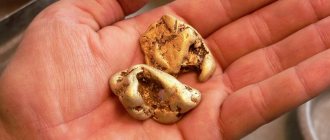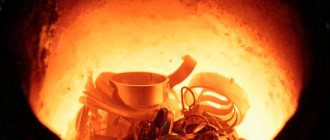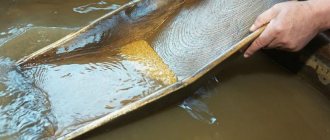Hello, dear readers! Today we will plunge into the world of gold mining and examine one of the main methods of extracting this metal. After all, not everyone knows exactly how it is taken out of the ground and separated from other garbage.
The problem is that in addition to nuggets in their pure form, the noble mineral is found in the soil in the form of fine dust. For the purpose of its removal, a device was invented, which will be discussed further - a dredge for extracting gold.
Methods of gold mining in Russia
Gold is considered an expensive, but still not a rare metal. Methods for its extraction from the soil are conventionally divided into mechanical and chemical (when combined with other elements). If we talk about the Russian Federation, the following are recognized as the main ones.
- Amalgamation is based on the special property of mercury to dissolve elements in itself. The rock containing gold is placed in a container with Hg. Over time, these metals combine to form an amalgam, from which the mercury is subsequently evaporated.
- Crystallization using NaCN - this method is very similar to the previous one, only instead of poisonous mercury, the gold-bearing rock is mixed with sodium cyanide, which, when combined with gold, forms yellow crystals.
- The dredge method is the use of a special floating installation (dredge), which collects enriched rock and washes out the precious metal from it.
These are the main methods of industrial gold mining in Russia. In addition to them, manual washing using a sieve is also widespread.
Extraction methods
There are the following options for mining yellow metal:
- manual;
- ore;
- hydraulic;
- using a dredge.
The first method involves washing gold, for example, with a tray. The second is applicable in industrial areas. Its implementation requires permission from the government, expensive equipment, and a mine.
The hydraulic method allows you to erode rocks under the influence of special equipment. The most common method, using a dredge, is used on a small and industrial scale. A mechanized device processes the soil, which presumably contains gold. Gold mining is carried out on land or at sea. Accordingly, a continental or maritime class machine is used.
Both types of machines are approximately the same. The only difference is the presence of piles and a stalker in continental models. Gold mining is considered profitable when 3 g of gold is obtained per 1 ton of rock.
What is a dredge?
Dredges are special machines designed to work with different types of soil. The main functioning element of such installations can be either a multi-bucket in-line mechanism or a suction hose (if the rock is loose). The scooping mechanism is adjusted by a staff of 10 people.
Simply put, this unit acts as an attachment that can be installed on a floating platform or ground transport, and is somewhat reminiscent of a conveyor. Only instead of a tape, movable scooping devices are attached to the frame. They are the ones who scoop out gold-bearing ore from a quarry or from the bottom of seas, oceans, rivers, etc. Subsequently, the extracted conglomerate containing the required element is transported for processing. Below is a photo of the car itself.
Passage under the bridge
Over thirty years of operation, the dredge completely exhausted the upper reaches of the river and came to rest on a railway bridge near the Berezit station. Its height was not enough for the dredge to pass, because the floating factory is a three-story structure. It was decided to raise the bridge.
Preparing the bridge for dredge passage under it
Four foundations were built near it, vertical trusses were installed on them, and powerful lifting winches were attached nearby. A dam was built below the bridge. A reservoir has formed. We calculated the water level for the dredge to pass in advance. Such a bold technical solution was implemented for the first time in the Soviet Union. The whole operation took 2 hours 20 minutes
Dredge device
If we talk about a dredge with a bucket working element, then there is nothing complicated in its design. However, there is also a vacuum type of installation, the design of which is different in many respects. It is intended for bulk deposits, which include marine gold-bearing sands. The machine consists of the following mechanisms.
- Pump - creates a suction effect.
- Sleeve - passes rock through itself under the influence of a created vacuum.
- Auxiliary hose - connected to a pump that pumps water, and directs it through a high-pressure pipeline into the hose.
- A sluice is a kind of container that calibrates the rock and throws away large debris.
- Butara - acts as a flushing mechanism.
All these elements work harmoniously, that is, together. Most often they are installed on a floating gold mining platform that operates on water. They are rarely used in quarries.
Operating principle of the dredge
Dredge equipment, regardless of whether it is a pump or a bucket, is designed for one purpose - the extraction of ore containing valuable minerals and its transportation to the destination, that is, to the place where the mined material is either processed or immediately washed (as in the case with gold).
For example, a bucket dredge most often simply dumps the mined conglomerate into a heap, but a floating pumping station immediately washes and collects pure gold, throwing unnecessary debris to the bottom. But the principle is the same - extract, transport and sift.
The realities of gold miners
Residents of the northern regions of Russia are more often involved in illegal gold ore mining, where there are more difficulties in obtaining a stable income. In the summer, the hard work of miners is easier to bear. In permafrost areas, the method of washing gold deposits is not at all possible.
In addition, the work of a gold miner is fraught with many dangers. It is necessary to overcome hundreds of kilometers of taiga in search of a gold mine. At the same time, you have to meet animals and unfriendly people.
Of course, this type of activity does not always require specialized education or knowledge in geodesy and cartography. Repeatedly, “by chance,” the miners’ production was not limited to a few grams of precious metal. They had at their disposal large pieces of gold - nuggets.
However, we should not forget that deposits of valuable ore are depleted every year. Often, scarce areas become unprofitable, and the mined precious metal cannot always be sold at the desired prices. Firstly, its cost directly depends on the quality of the breed. For this reason, each ingot has its own marking. Secondly, this type of activity is heavily criminalized. In addition, illegal mining is prosecuted by government agencies.
Classification
The global specification distinguishes two main types of machines.
- 1st class (quarry dredges) - work in artificially created reservoirs on floating platforms.
- Class 2 (water dredges) - designed for the extraction of bulk rocks from the bottom of seas, lakes, etc.
In addition, dredge installations can be divided depending on their design features and capabilities.
- By type of energy used.
- According to the method of movement.
- Depth of extraction.
- Depending on the type of bucket.
- According to the size of the scoop.
- Method of operation of the bucket chain.
There are quite a few different classifications of installations, but the main one is considered to be the world one, that is, 1st and 2nd classes.
Mini dredge
Another variety is a compact unit that resembles a full-fledged pumping dredge platform. At its core, this is the same installation, only in a smaller version and, accordingly, with limited productivity. It is used mainly by hired miners engaged in legal gold mining.
Gold mining: equipment
Industrial gold mining is carried out using dredges. This is a bulky unit weighing several tons and the size of a four-story building. The device is equipped with a mechanism with scoops that lifts soil from the bottom of the reservoir. Next, it goes through several stages of washing, as a result of which the metal is separated from the soil and deposited at the bottom of the trays. The advantage of using a dredge is that all stages of gold mining are concentrated on it. A relative disadvantage is that the unit cannot operate without water.
There are two types of industrial dredges:
In both cases, due to the cost, only large mining companies with a state-owned scale of activity will be able to afford to purchase such equipment. For small cooperatives and individual entrepreneurs, mini dredges are more suitable, the prices of which are several orders of magnitude lower.
How to check the flushing unit?
Before mining gold, the equipment should be thoroughly checked. The bottom line is to test the gateway for performance, namely, the capture of small particles of gold from the ore. To do this, take some dense metal, for example, lead, and paint it in a bright color. After this, it is poured into a portion of soil and washed.
Thus, the dredge will catch brightly colored metal no worse than gold. If only 2-3 pieces are lost in the process, then the unit can be considered quite serviceable, and in practice it will perform well.
About technology
The width of the face is approximately 60 meters. Having worked one, the dredge steps forward - moves forward 2.5-3.5 m to work a new face. Three or four of them are worked per shift.
The volume of each scoop is 250 liters. A total of 82 scoops move along the chain
A scoop chain of 82 scoops with a volume of 250 liters (before the reconstruction of the dredge in the mid-70s, this value was 210 liters) removes rock from the surface of the earth. The maximum depth is 11 meters. While developing the thickness of the placer, the dredge delivers all the removed rock for washing. Particles with the highest specific gravity (this is gold) are retained and accumulated during this washing on the rubber mats of the sluices.
Rinsing (eating the enriched product) is carried out by the so-called “rinsers” and closers (there are five of them on the dredge). The work is not complicated - the technology has been proven for a long time - but it is monotonous and requires patience, attentiveness and accuracy. Many women have been working here for many years and passing on their skills to young people.
But for other processes, strong male hands are needed. Machinists, mechanics and electricians, mechanics, gas-electric welders... Winter major repairs do not require the involvement of third-party specialists: the same team works. Therefore, versatility is especially valued here.
After going through the entire mining and beneficiation process, the metal is brought to purity on a concentration table. The rest of the rock goes into dumps. The resulting gold is delivered to a non-ferrous metals processing plant; the bullion is sold to the bank.
Is it possible to make a dredge with your own hands?
Based on what was written above, it is theoretically possible to make a mini dredge, but you will have to buy some additional parts. In any case, it will be much cheaper than purchasing a new device (about 3 times). However, it is not a fact that a device assembled by yourself will work well. When designing, you need to take into account many nuances.
Required tools, materials and components
Self-production only involves assembling all the mechanisms into one whole, since it is almost impossible to construct them with your own hands. The list of what you will have to buy consists of the following units.
- Motor - it will turn the main elements.
- Pump - a centrifugal water pump is suitable.
- Compressor - needed to produce air for breathing underwater.
- Pipes are a readily available material.
I would like to draw your attention to the fact that the pump and compressor must be attached to the motor and use its energy to function. Therefore, when purchasing, you need to ensure that their installation is as simple as possible.
You can also buy a gateway, but it’s quite possible to make it yourself. To do this, you will need aluminum profiles, galvanization and metal of various shapes.
General form
Conventionally, mini dredges are divided into portable and stationary (more productive). The latter are considered more cost-effective because they can operate in deeper bodies of water and are equipped with a compressor to generate air so that the miner can remain under water for a long time. General diagrams and drawings of such installations are presented below.
Gateway drawing
Gateway diagram
General scheme of dredge operation
General view of the installation
In addition to these, there are also so-called hand dredges, which are convenient to work with in shallow water or in streams. The principle of operation is the same, only all the equipment is attached very compactly, which allows you to carry it in your hands. The unit itself is somewhat reminiscent of a vacuum cleaner for gold.
Famous Bottlenose Dolphin 1000
Dredge cost: current offers
We analyzed the proposals on thematic Internet resources and came to the conclusion that the cost of industrial installations is negotiated on an individual basis.
Important
On the website of manufacturers of such equipment, after a detailed description of the models available for purchase, there is a message that to clarify the price you need to contact the seller.
For example, one of the sites we studied presents a wide range of Julong industrial dredges. The seller offers consumers a wide variety of models - amphibious self-propelled crawlers, mine, bucket, jet suction dredges, portable and stationary installations - the choice is huge, however, in the “Price” column, “Negotiable” is indicated everywhere.
As for options for private use, the situation here is as follows:
- Mini dredge Keene 4500 RN from a reputable American manufacturer, Engineering, costs 450 thousand rubles. The seller, according to the data presented on the website, is located in Krasnoyarsk.
- The Russian-made mini-drag “Nugget-50” costs 139,400 rubles and is sold in the city of Bratsk. A less powerful model from the same manufacturer, “Nugget-40,” costs much less – 75 thousand rubles. All the models we mentioned, according to the seller, are new and are covered by a factory warranty.
Work progress
So, you need to start building a dredge for gold mining with a frame for which metal profiles are suitable. It can be of any shape, but it is advisable to make it so that it is easy to install attachments later.
After collection, floating elements (tanks, barrels, hollow pipes) are installed on the created base, which will allow the entire installation to move freely on the surface of the water.
When the main part is ready, you can attach the motor to the frame, and then the pump and compressor to it. Then, accordingly, install pipes - one for collecting water, the second for supplying it under pressure, the third, the most massive, for collecting ore, sand, etc.
The last thing to install is a gateway, which is connected to the main hose, after which the homemade mini dredge is checked. To better understand exactly how it works, you can watch the video.
How to look for gold correctly
Finding gold is a very long process that can last for years. It is unlikely that in the first days of searching the digger will find something worthwhile. In order to somehow speed up this process and make it more productive, it is recommended to study a large amount of literature that can teach you how to properly organize your searches.
It has already been said that gold is found in quartz strata. To detect them, you need to pay attention to certain signs that are characteristic only of such deposits.
How to pan or mine gold yourself using a mini dredge?
Before engaging in such a business, you need to know that the mining of precious metals is considered illegal and is punishable in accordance with current legislation. However, this does not stop gold miners, which results in the widespread spread of this fishery in the eastern part of Russia.
You can work with such a device both on land and in reservoirs, but in both cases a water supply is required. In the first, the ore will enter the gateway under the influence of injection, and in the second, it will be done manually, that is, you will have to work with a shovel. There is no particular difference between these methods, and they are both applicable.
About the team
The dredge employs 26 people. These are mostly Berezovka residents. To stay to work here - and the conditions are not easy - you need, if not to love, then certainly to accept this place, its peculiar romance. Not many of those who try remain on the ship-enterprise, but if they stay, then for a long time. Today you can see people from 25 to 60 years old at the drag race, but mostly the team is older and mature.
It is easy to calculate that since 1934 the third generation has been working here. In the past, when many processes were carried out with the help of hands rather than machines, there were many more workers. Over time, with the development of technology, many professions disappeared from the dredge. For example, metal finishing used to be completely manual; coastal workers (sailors) were replaced by machinery.
To reach the workplace only by boat
Where and who can I learn to become a dredge worker? There is no clear answer. Miners, of course, are closest (annual excursions are held at the dredge for students of the Ural Mining University), but on-site training is also an option. The main desire. It is more difficult today to find representatives of blue-collar professions.
Salary is made up of several factors. Dredge workers earn more than representatives of the same professions at a regular enterprise: working conditions and the need to spend most of their time outdoors, regardless of temperature, have an impact. People retire from here earlier: professions are “preferential”.
The “captain” here is the head of the dredge. One of the most important positions is the dragger; his place here is, one might say, honorable. Responsibility for dredging and compliance with all technological rules lies with him. Control is carried out from the control panel in the so-called “dragger”.











